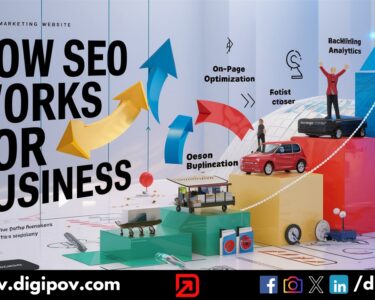Search engine optimization remains one of the primary tools for businesses to gain an advantage in the always evolving world of digital marketing. To be specific, search engine optimization allows a company to:
1) increase visibility . In other words, the firm can capture attention,
2) attract organic traffic and
3) boost conversions .
On-page optimization is the heart and soul of SEO – it shows search engines the website’s offerings, strengths and relevance, directly impacting the search rankings and the ultimate output of the whole endeavor. This comprehensive guide will review on-page SEO, its fundamental aspects, best practices, actionable tips and tricks to get the most of it.
Understanding On-Page SEO:
On-page SEO involves improving individual web pages to make them more appealing to search engines. Unlike off-page SEO, which focuses on external factors like backlinks, it goes beyond that as on-page SEO optimizes elements within a webpage to enhance its relevance, authority, and user experience.
Key Elements of On-Page SEO:
When it comes to on-page SEO, there are key factors that you should focus on, and these include:-
1.Enhancing Your Content:
It’s important to optimize your web page content material for search engine marketing. Make certain it’s descriptive, enticing and tailor-made to satisfy the wishes of your target market. Great content captures readers’ interest away while also assembling the criteria of seek engine algorithms.
As part of your content optimization method delving into keyword research is key to coming across seek terms and terms that suit what customers are seeking out.
2. Optimizing meta tags:
Meta tags, such as title tags and meta descriptions, give search engines and users key information about your webpages.
- Title tag:- You must create attention-grabbing and descriptive title tags that include relevant keywords. This improves your webpage’s visibility in search results and entices users to click on it.
- Meta description:- Write brief and compelling meta descriptions that accurately reflect your webpage’s content. They can increase click-through rates and enhance user engagement. While meta keywords don’t directly impact search rankings, they can still help search engines understand your page’s relevance to certain subjects or topics.
3. URL Structure:
The structure of a website’s URL affects how easy it is to use, how well it can be found by search engines, and how well it ranks. URLs that are easy to understand and consistent with the content of the page make it easier for people and search engines to navigate your site. Important keywords should be included in the URL, especially near the beginning.
4. Custom title tags:
Title tags (e.g., H1, H2, H3) organize the website content into a hierarchical structure. This improves visitor readability and helps search engines understand the page content. The H1 tag is the main title and should briefly describe the main topic of the page by including relevant keywords. Subsequent heading lines (H2, H3, etc.) divide the content into sections and subsections. Consider using relevant keywords in these topics as well to make the content more relevant to search engine queries.
5.Optimize Your Images:
Images are what make your website attractive and interesting to interact with. It’s important to make sure your images are simple and make sense for search engines to improve site optimization. Define them clearly in the ‘alt’ tags and include your focus keywords because of how the engine understands that your website is relevant to specific search queries. Don’t forget to compress your images and make them smaller. It will help your pages load faster and improve the performance of your website, in general, too. It will help create a better user experience and can even get you to the top.
6.Internal backlinks:
Using links on your site to other parts of the site is as important as backlinks. Writing that should be logically and appropriately phrased. Placing such a link at the bottom of your article will direct readers to easily accessible information on the topic or other linked topics. This feature of redirects enhances the structure of your website, making it easier for crawlers to navigate.
Best Practices for On-Page SEO:
1. Always Focus on User Experience:
Google has made it clear that website owners need to focus on providing the fine possible user revel in while optimizing the hunt engine. The website has to be clean to use, brief to load, and mobile-pleasant. Users can effortlessly get admission to any information they want to get entry to. Also, the website must offer good information that fits their studies type.
2. Always follow search engines algorithm modifications:
Search engines’ algorithms exchange all the time. Regularly tracking such adjustments is important for powerful on-page search engine optimization strategies which could enhance your search engine ranking. Rely on industry blogs, forums and depended on news companies for the most updated facts.
3. Audit and optimize frequently:
It is crucial to periodically audit and optimize the SEO elements on the page. Technical issues with web sites can harm search engine ratings so entrepreneurs ought to behave in-intensity audits every now and then. This manner, they are able to ensure that their content material follows nice practices and that on-web page factors together with meta tags and URLs are suitable. Monitoring website metrics like key-word scores, organic traffic, and the way human beings are the use of the website online affords precious comments on how well on-web page optimization is operating
4. Leverage Schema Markup:
By providing context to the page, schema markup helps search engines to interpret the websites better. This interpretation can aid in the display of rich snippets, and increase SERP features of the webpage. Optimizing your website assets and content is essential; this can be done using schema markup in types such as articles, products, reviews, events, and FAQs is an effective way to ensure that your website content stands out from the rest, thus increasing the website’s visibility, relevance and user experience in search results.
5.Ways to Enhance Rich Results for Featured Snippets:
Just think, the most crucial spots on the search engine result pages are amalgamated with featured snippets and rich results. It allows the web pages to increase their visibility and traffic. To optimize content for featured snippets, it’s significant to provide direct and clear cut answers to the frequent question of the users. Also, it’s important to modify the content’s structure depending on the intent of the users searching. Apply schema markup and formatting like bullet points, numbering and table for increasing rich results for the contents in search engine results.
On-Page SEO vs Off-Page SEO
| Aspect | On-Page SEO | Off-Page SEO |
| Definition | On-page SEO implies improving the SEO factors of the elements present on the website itself. | Off-page SEO indicates the off-site activities performed to improve the website’s visibility and authority. |
| Focus | The content’s quality, keywords, meta tags, site speed, the website’s mobile-friendly nature, internal linkings. | The off page-seo includes link building, social media marketing, influencer outreach, and brand mentions. |
Goal | Improve relevance and quality of the website’s content for search engines and users. | Increase website authority and trustworthiness through external signals like backlinks. |
Examples | Content optimization, keyword research, meta tag optimization, URL structure optimization. | Link building campaigns, guest blogging, social media engagement, influencer collaborations. |
Impact | On-page SEO consists of such factors that directly affect the search engines to perceive and rank the content on your website. | Off-page SEO refers to the activities performed outside the boundaries of the website to improve the position of the website in the search engine rankings. |
Control | Within the website owner’s control; changes can be made directly on the website. | Partially within the website owner’s control; relies on external factors like other websites linking to yours. |
Time Investment | Requires ongoing maintenance and updates to ensure content remains relevant and optimized. | May require substantial time and effort to acquire quality backlinks and build online reputation. |
Importance | Critical for establishing a strong foundation for SEO and ensuring content is accessible and relevant. | Essential for building authority, credibility, and trustworthiness with search engines and users. |
Conclusion:
Summing up, we can say that doing your website content and other elements (On-page SEO) the mark is very important to make it visible, relevant and improve the user experience. These things include finetuning the content, meta tags, URL, Heading tags, and images. It is best to do what’s best, update ourselves with the changes in algorithm, use advanced techniques like schema markup and featured snippet optimization to bring your website up in the search engine ranking and relevant organic traffic to your website. A good business that follows on-page seo can improve digital marketing and get beneficial results.
Frequently Asked Questions:
Q1: How does on-page SEO differ from off-page SEO?
A: Individual web pages have been enhanced to increase on-page SEO and attract targeted traffic from search engines. The process includes improving the overall content of the page, as well as optimizing the HTML code and images that appear on it.
Off-Page SEO includes techniques and techniques that are employed off-site to increase your website’s visibility, credibility, and appeal. This includes efforts such as building backlinks and engaging in social media marketing aimed at increasing the authority of your website or website and increasing its profile.
Q2: How important is keyword research in regards to on-page SEO?
A: Keyword research plays an important role in on-page SEO because it allows you to set recommended search terms and phrases that your ideal audience is likely to use when searching for services or services similar to yours. By incorporating these keywords into various elements of your website, such as text and meta tags, you can increase your visibility and ranking in search engines and attract quality organic traffic to your website. in the workplace.
Q3: What is the importance of user experience in on-page SEO ?
A: An important aspect of on-page SEO is the user experience (UX) because it affects how visitors interact with your website and content. Search engines love websites that offer a unique browsing experience and meaningful content. High-end UX features include quick load times, mobile-friendliness, and straightforward site navigation. Effective user engagement also increases satisfaction levels, as well as the overall search engine ranking power of your website.
Q4: What is the frequency of on-page SEO audits?
A: It is recommended that you monitor on-page SEO at regular intervals to look for areas of improvement that could affect your site’s performance and fix technical issues. The frequency of on-page SEO audits can vary depending on the size and complexity of your website. Keep an eye on changing SEO algorithms and changing trends in your industry as well. You may need frequent on-page SEO surveys to compete effectively all the time.
Q5: Is schema markup a ranking factor for on-page SEO?
A: No, schema markup is not a direct ranking factor when it comes to on-page SEO. But using schema.org terminology to tag HTML in order to support more informative search engines for users. Schema markup provides additional context for search engines and helps create nice and transparent snippets. This can drive more traffic and more reliable results in the SERP. By using schema markup, you can make your website look cleaner and more informative in the eyes of search engine users.
Q6: What are the optimal processing methods for displayed details?
A: To optimize your content for the details displayed, you should focus on the questions listed in your projects. When writing, focus on giving short, relevant answers. That content format objective makes the back of the mind ‘user intent to search’. Using basic formatting elements such as bullet points and tables to break down information into sections. Correct the user query to increase the chances of your site showing up for details in search results.



